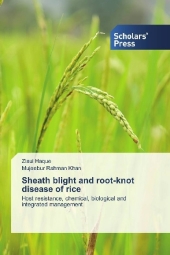 Neuerscheinungen 2017Stand: 2020-02-01 |
Schnellsuche
ISBN/Stichwort/Autor
|
Herderstraße 10
10625 Berlin
Tel.: 030 315 714 16
Fax 030 315 714 14
info@buchspektrum.de |

Ziaul Haque, Mujeebur Rahman Khan
(Beteiligte)
Sheath blight and root-knot disease of rice
Host resistance, chemical, biological and integrated management
2017. 152 S. 220 mm
Verlag/Jahr: SCHOLAR´S PRESS 2017
ISBN: 6-202-30219-4 (6202302194)
Neue ISBN: 978-6-202-30219-7 (9786202302197)
Preis und Lieferzeit: Bitte klicken
Rice is world´s most important cereal crop and it is a crop of life, culture, stability and sustainable development. The major constraint in rice production is regular occurrence of pest and diseases. Sheath blight incited by Rhizoctonia solani (anamostosis group 1-IA, teleomorph Thanatephorus cucumeris) is one of the most destructive and notorious disease worlds over, and hampers the rice productivity up to 30%. Rice root-knot nematode, Meloidogyne graminicola, is another important pest of rice and emerging threat to the rice cultivation, particularly in the Southeast Asia. The nematode attacks rice in the nursery as well as in the main field and incite 16-32% yield loss to the crop. A perusal of literature and critical analysis of the relevant information has been collected and bring out a well-documented and comprehensive review on sheath blight and root-knot disease of rice with special reference to their host resistance, chemical control, use of biocontrol agents (Aspergillus niger, Pochonia chlamydosporia, Purpureocillium lilacinum, Penicillium spp., Trichoderma spp., Bacillus subtilis, Pseudomonas fluorescens, P. putida) and integrated disease management (IDM).
Dr. Haque obtained his Ph. D. degree from Aligarh Muslim University, India in Plant Pathology and Nematology and possesses over ten years of teaching and research experience. He has published more than 20 research papers, review articles in reputed journals. His area of research focuses on biological control of plant pathogens and phytonematodes.


